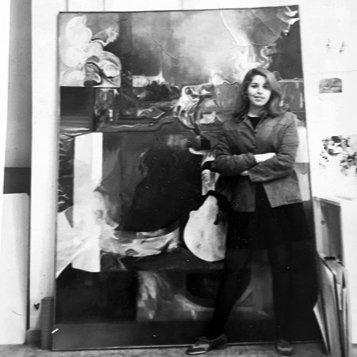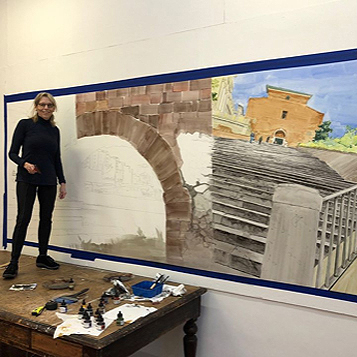ARTIST STATEMENT
Water has both mythological and ecological significance and my paintings represent my interest in the natural and the preternatural. They constitute a dialectic --with movement, danger and dynamism in juxtaposition to the frozen stasis of timeless belief.
Watercolor provides a familiar but ever changing spectacle. I use YUPO, a synthetic paper with its impermanent slick and slippery surface. Except for the initial laying in of the ground, I forsake the traditional painter’s brush for cotton balls, Q-tips and Bounty paper towels. One sneeze and the images could be erased forever.
Recent 12-foot watercolors completed at the American Academy in Rome capture sites and locations that are iconic images from the films of Italian directors Federico Fellini, Pier Paolo Pasolini, and Paolo Sorrentino.
Read Mark Segal’s interview Hallie Cohen: Living the Vita Dolce in the East Hampton Star.
MARY PROENZA ON HALLIE COHEN
In Hallie Cohen’s hands, the famously hard-to-handle medium of watercolor — her "drug of choice" —becomes a metaphor for investigating questions of art and nature. Her primary themes are gesture and water. Their flux and flow are so convincingly echoed in the deft form of her work that this could be sufficient. Yet she offers further eye-and mind- opening experiences, particularly by rejecting artistic complacency and slyly upending common notions. Cohen's work as a whole, bears a global aspect, lke a kind of map of creation. It stakes out a divide between natural and imagined worlds.
RICHARD LORBER ON HALLIE COHEN
Mid-career artists often consolidate their artistic strategies to arrive at aesthetic completion within boundaries of comfortable tropes and established styles. Thus it's all the more refreshing to encounter a surprising departure in the new watercolors of Hallie Cohen.
Moving beyond her previous work's accomplished conceits of ironic illustration, here she unleashes a fluid gestural vocabulary suggestive of influences as diverse as Southern Sung landscape, Morris Louis's "Unfurleds" and Ross Bleckner's submerged, inchoate forms, but without any evident derivativeness.
Loosely washed but meticulously manipulated surfaces revel in tactile hand making while flirting with the gravitational autonomy of natural processes. But this is not an art of automatism and accident. Cohen's expressionist bravura teases viewers in only to show them the door...to a more bracing agenda. Ultimately form and emotion remain undiscoverable here. Aspiring to indexical signification, written as it were with many instruments and marks in astringent, inky hues, she stresses these planar fields to reveal the tensions of their own dematerialization. In the end we are seduced, but by a fascinating twist of expectation. It's a subverting of illusionism that snaps pleasure to attention.

